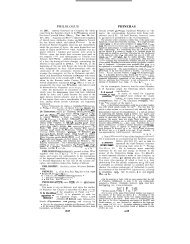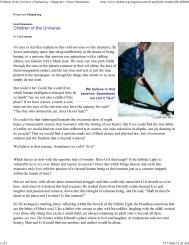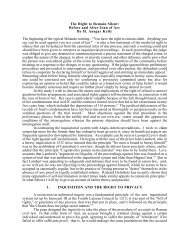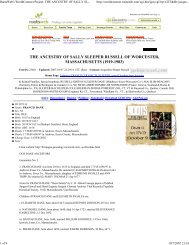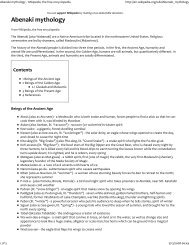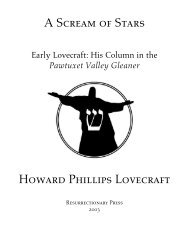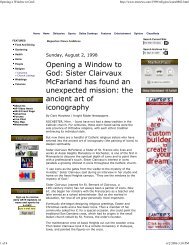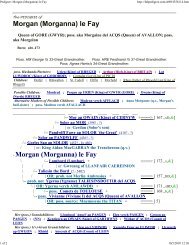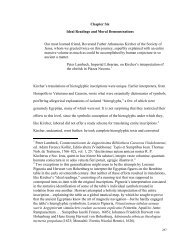Encylodaedia Biblica; a critical dictionary of the literary, political and ...
Encylodaedia Biblica; a critical dictionary of the literary, political and ...
Encylodaedia Biblica; a critical dictionary of the literary, political and ...
You also want an ePaper? Increase the reach of your titles
YUMPU automatically turns print PDFs into web optimized ePapers that Google loves.
ZOBAH ZOHELETH, STONE OF<br />
; in Jer, 48 34 zorop CB~Al vg, Segor), a<br />
locality mentioned in Gen. 13 IO 142 8. 19 22 f. 30 ’ Dt.<br />
or ARAM-ZOBA (KIjY ‘N, z S. 106 8, but<br />
1. The<br />
RV AR.4M-ZOBAH), <strong>the</strong> home <strong>of</strong> one <strong>of</strong><br />
<strong>the</strong>ory.<br />
David’s ‘thirty’ (z S.2336; AYNAM~UC<br />
[BA], MACCABA [L]).’ also <strong>the</strong> name <strong>of</strong><br />
an Aramaean state, whose king Hadadezer was defeated<br />
by David (z S.8r-14 10158). In I S.1447 ‘<strong>the</strong> kings<br />
<strong>of</strong> Zobah ’ are said to have been defeated by SauL2 <strong>and</strong><br />
in z Ch. 83 Solomon is asserted to have taken Hamathzobah<br />
(patuwga [B], acpa0” uoupa [A], epa0a. [L]) ;<br />
<strong>the</strong> latter designation is thought to imply <strong>the</strong> same<br />
(erroneous ?) conception <strong>of</strong> <strong>the</strong> importance <strong>of</strong> Zobah<br />
which is found in (a) z S. 83 8 1015-1ga, but not in <strong>the</strong><br />
narrative (6) which contains z S. 101-14 196. This at<br />
least is clear, that in <strong>the</strong>respective strata <strong>of</strong> narrative<br />
different views <strong>of</strong> <strong>the</strong> position <strong>of</strong> <strong>the</strong> kingdom <strong>of</strong> Zobah<br />
are suggested. If <strong>the</strong> view implied in <strong>the</strong> former<br />
stratum (a) is correct, <strong>the</strong> idea that David was one <strong>of</strong><br />
<strong>the</strong> mightiest monarchs <strong>of</strong> his time is not an extravagant<br />
one, for here <strong>the</strong> kingdom <strong>of</strong> Zobah under Hadadezer<br />
is represented as dominating <strong>the</strong> whole <strong>of</strong> Syria,<br />
whereas in <strong>the</strong> latter stratum (6) Zobah appears with<br />
BETH-REHOB, MAACAH, <strong>and</strong> ISHTOB or TOB, as an ally<br />
<strong>of</strong> <strong>the</strong> Ammonites. This difference <strong>of</strong> view has been<br />
explained by <strong>the</strong> supposition that two different Zobahs<br />
have been confounded (see DAVID, g, with n. 2,<br />
where references are given for <strong>the</strong> evidence). One, to<br />
<strong>the</strong> N. <strong>of</strong> Damascus <strong>and</strong> Hamath, rich in copper<br />
(z S. 88), was conceivably <strong>the</strong> mat NuhaIBi3 <strong>of</strong> <strong>the</strong><br />
Am. Tablets (375 45 22, etc. ), if NuhaSSi means ‘ copper ’<br />
(ntn?), according to Halevy’s <strong>the</strong>ory (REJZOzrg ; cp<br />
COPPER, 5 3). The o<strong>the</strong>r Zobah corresponds to <strong>the</strong><br />
‘ districts <strong>of</strong> Subitu,’ referred to by AIur-bani-pal (KB<br />
2 217), <strong>and</strong> was S. <strong>of</strong> Damascus, perhaps (so Wi. AOF<br />
1467) between Haurjn <strong>and</strong> <strong>the</strong> Sea <strong>of</strong> Galilee. Two<br />
cities <strong>of</strong> <strong>the</strong> former Zobah (as we may provisionally say)<br />
are named in z S. 8 8, viz., Ektah <strong>and</strong> Berothai (on <strong>the</strong>se<br />
see TEBAH, BEROTHAI, BEROTHAH).<br />
1 Marquart’s suggestion (see JOEL, 3) to read is only a<br />
ste towards <strong>the</strong> right solution (see 5 2).<br />
ZThis, however, is probably due to a partisan <strong>of</strong> Saul, who<br />
wishes his favourite to vie with David (SAUL, 5 3).<br />
3 Halevy supports this by <strong>the</strong> conjecture that illis is a contraction<br />
<strong>of</strong> >$?:, ‘bright yellow,’ <strong>and</strong> compares Xdrk from<br />
ah&, ‘copper.’ Chalcis was on <strong>the</strong> slopes <strong>of</strong> Antilibanus (cp<br />
ai. A T Unfers. 180). On <strong>the</strong> situation <strong>of</strong> NuhaHgi, cp Flinders<br />
Petrie, Syria <strong>and</strong> Egypt, 179.<br />
5425<br />
A1T <strong>of</strong> <strong>the</strong> passage <strong>of</strong> 2 S. referred to. There is grave reason,<br />
however, to hold that this assumption is<br />
2. New <strong>the</strong>ory. erroneous. The Aram with which David<br />
had relatiorrs vas, according to <strong>the</strong> still<br />
discoverable earlier’form <strong>of</strong> <strong>the</strong> traditions, not <strong>the</strong> nor<strong>the</strong>rn but<br />
a sou<strong>the</strong>rll Aram--i.e., <strong>the</strong> Jerahmeelites <strong>of</strong> <strong>the</strong> Ne&, <strong>and</strong>,<br />
343 Is. 155 Jer. 4834t. It is commol~ly placed to <strong>the</strong><br />
SE. <strong>of</strong> thi ~~~d sea, which may be so far as<br />
Is, 155 <strong>and</strong> Jer, 4834 are concerned, but hardly for Gen, if we use <strong>the</strong> manv parallels <strong>and</strong> analogies <strong>of</strong> o<strong>the</strong>r restored<br />
<strong>and</strong> Dt. (Uic.).<br />
passages it is not difficult to recover <strong>the</strong> probable originals <strong>of</strong><br />
There is in fact a considerable body <strong>of</strong> eyidence for <strong>the</strong>view names oiplaces miswritten by <strong>the</strong> redactor. It should, however,<br />
that <strong>the</strong> chief seat <strong>of</strong> <strong>the</strong> sou<strong>the</strong>rn Israelitiph legends was <strong>the</strong> first <strong>of</strong> all, be noticed to <strong>the</strong> credit <strong>of</strong> Winckler that, noticing<br />
Jerahmeelite territory, bordering on Muv <strong>and</strong> Edom. See <strong>the</strong> combination <strong>of</strong> Beth-rehoh <strong>and</strong> Zobah, <strong>and</strong> <strong>the</strong> designation<br />
ISAAC, JACOB, <strong>and</strong> especially SODOM ANU GOMORRAH. The <strong>of</strong> Hadad-ezer, king <strong>of</strong> Zobah, as Beth-rehob, he has suggested<br />
play on <strong>the</strong> meaning <strong>of</strong> ‘ Zoar ’ in Gen. 19 20 22 is only accounted that both names represent one <strong>and</strong> <strong>the</strong> same state (GI 1141J).<br />
for if <strong>the</strong> true name <strong>of</strong> <strong>the</strong> city was iyso, or ra<strong>the</strong>r ny,?i.e., This is in fact very near <strong>the</strong> truth. The statement in 2 S. 8 3<br />
Mi& (hlusri). The ‘ Zoar ’ <strong>of</strong> legend was really ‘ Misur ’ ; it should’probahiy run thus, ‘And David smote Hadad [. . . .I, a<br />
w2’one <strong>of</strong> <strong>the</strong> cities<strong>of</strong> Musriin N. Arabia, towardsS. Palestine. native <strong>of</strong> Rehohoth, king <strong>of</strong> Zarephatb,l when he went to tnrn<br />
Cp MISRAIM, $ 2 (b). Upon <strong>the</strong> new <strong>the</strong>ory, Gen. 13 10, where him [David] back from <strong>the</strong> river [<strong>of</strong> Mu$ri].’z Verse 8 in its<br />
‘Zoar’ appears to be distinctly placed in <strong>the</strong> Jordan valley, original form probably spoke only <strong>of</strong> one royal city, viz.,<br />
originally ran thus, ‘ And Lot lifted up his eyes, <strong>and</strong> saw that Rehoboth; <strong>of</strong> this Berah gives one <strong>and</strong> Berothai ano<strong>the</strong>r<br />
<strong>the</strong> whole <strong>of</strong> Jerahmeel (p,~ 133, a primitive corruption <strong>of</strong> corruption.3 In 106 <strong>the</strong> allies <strong>of</strong> <strong>the</strong> h‘ne Ammon were probably<br />
given as Aram-rehoboth (to which Aram-zoha is probably ,a<br />
5~pn-p) was well-watered [before Yahw.5 destroyed Sodom <strong>and</strong> gloss) 4 Maacah (<strong>the</strong> sou<strong>the</strong>rn Maacah), <strong>and</strong> Tubal ; Helam in<br />
&&orrah] like <strong>the</strong> gard;: <strong>of</strong> Yahwt., like <strong>the</strong> l<strong>and</strong> <strong>of</strong> Migrim, vu. ~br: represents Jerahmeel (place-name). In I S. 1447<br />
in <strong>the</strong> direction <strong>of</strong> Missur. Here, however, it is probable that<br />
>xis *>in (‘<strong>the</strong> kings <strong>of</strong> Zobah’) is miswritten for ngir honi-<br />
Misgur really means <strong>the</strong> Z<strong>and</strong> <strong>of</strong> MisSur ; O;?rS f‘$ may be (Jerahmeel-zarephath); see SAUL P, 7. In 2 S. 23 36 we need<br />
omitted as an unintellijent alteration <strong>of</strong> l?Xn ”&I. Ball (cp not question <strong>the</strong> reading, ‘Igal,’ b.’Nathan, <strong>of</strong> ‘Zobah,’ for<br />
‘Zohah ’ here too represents ‘Zarephath, while Igal’ (like<br />
GARDEN, P, 4, n.) prefers reading @ ‘Zoan ’ (Pesh. ?). But ‘Joel’ <strong>and</strong> ‘ Gaal ’) is a popular corruption <strong>of</strong> ‘ Jerahmeel.<br />
surely ‘ like <strong>the</strong> l<strong>and</strong> <strong>of</strong> Egypt ’ was Ylear enough, without a That ‘ Zarephath ’ should sometimes be used con~prehensively,<br />
limiting or explanatory appendage. Egypt,’ however, is not some$mes with a narrower reference, affords no ground for<br />
to be expected in this context, <strong>and</strong> <strong>the</strong> Hebrew traditions surprise. ‘Zarephathites ’ is constant1 used widely, <strong>and</strong> yet<br />
centre (as new evidence appears to shqw) in <strong>the</strong> Negeb <strong>and</strong> primarily, <strong>of</strong> course, it merely meant <strong>the</strong> people <strong>of</strong> <strong>the</strong> city <strong>of</strong><br />
<strong>the</strong> N. Arabian border. For <strong>the</strong> later traditional view <strong>of</strong> Zoar Zarephath. On ‘ Hamath-zohah ’ (Maacath-zarephath), z Ch. 83<br />
see MOAB. <strong>and</strong> on <strong>the</strong> whole question <strong>of</strong> <strong>the</strong> original Zoar see SOLOMON $7.<br />
Cp SODOM. T. K. C. NSldeke (hL 1232) places Zobah ‘nearly in <strong>the</strong> region <strong>of</strong><br />
ZOBAH (883, COYBA [BAL]), or more fully ARAM- Emesa. Elsewhere (see MEROM) it is suggested that Merom<br />
(Josh. 11 5 7) may he <strong>the</strong> second or more sou<strong>the</strong>rly Zohah.<br />
ZOBAH (8nY D78, Ps. 80 heading, CUBAA [BNR]),<br />
T. K. C.<br />
ZOBEBAH (8)3%tl), with ‘ hub’ <strong>and</strong> <strong>the</strong> ’ families<br />
<strong>of</strong> Aharhel, <strong>the</strong> son <strong>of</strong> Harum,’ is (perhaps) connected<br />
genealogically with Tekoa (>IT Coz [q.~.]), I Ch. 48<br />
(CABABA [BI, CUBHBA [A], CAB. [L]). See TEKOA.<br />
ZODIAC (Ilh!p), Job3832 RVmg., EV MAZZAROTH<br />
(4.~. ). See also STARS, 5 3 (d),<br />
ZOHBR (ink, 8 66 : ‘ reddish-white ? ’ see COLOURS,<br />
I 7 ; CAAP [BADEL]):<br />
I. Probably <strong>the</strong> name <strong>of</strong> <strong>the</strong> clan to which Ephron <strong>the</strong> Hittite<br />
(from Rehohothite [?I, see REHOBOTH) belonged (Gen. 238 259).<br />
Possibly we should read ”?!, ZERAH.<br />
2. h. SIMEON<br />
(5 9); see Zerah (4).<br />
3. b. Ashhur, a Judahite (1 Ch. 4 7 ; Kr. 1041, ‘ <strong>and</strong> Zohar.’<br />
RVmg. ; Kt. ins?, see IZHAR, 2 ; xdr u. [BPI, rai wrap [Ll).<br />
ZOHELETH, STONE OF (n$g;r jq~, I Serpent’s<br />
Stone ’ [BDB], but see below). This stone was evidently<br />
sacred, like <strong>the</strong> fountain En-rogel beside which it<br />
stood, <strong>and</strong> in <strong>the</strong> building which enclosed it Adonijah,<br />
as claimant <strong>of</strong> <strong>the</strong> crown <strong>of</strong> Israel, probably held his<br />
sacrificial feast (I K. 19).<br />
Gk. readings are : h&ov 701



